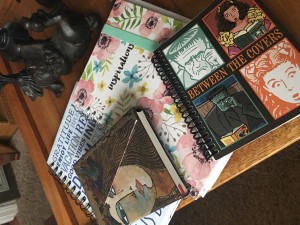You may think I’m going to talk about the famous Nicolas Sparks movie that everyone loves and correlate it to everyday life. But, no.
I’m talking about the power of keeping a notebook by your side, everywhere you go, to record your thoughts, ideas, learning points, motivational quotes, dreams, goals and connections.
The power of a notebook is simple and yet so profound. If you carry around a small pad with you everywhere you go, nothing you ever think, hear or say is lost to you. You never have to worry about whether it will come back around again or what happens if you forget it completely. It’s there – in ink. Until you decide to deal with it.
And I am a big believer in carrying one with you to meetings, keeping one on your desk, in your car, in your purse, on your nightstand – everywhere you may need one in case something sparks.
And don’t forget the ‘dealing with it’ part. It’s not enough to keep writing things down. You have to do something with them or those ideas are no good to you.
So here’s an example of what’s in one of the notebooks that I carry around:
Notes from a Women Entrepreneurs’ meeting in May about the Imposter Syndrome, minutes from a board I serve as Secretary, notes from a conference call for a client, ideas for speakers for my podcast, Just 5 Minutes blog ideas, a couple of quotes and some personal goals. In another notebook, I keep notes on books I am reading and books I want to read during the month. (yeah, bookish girls make monthly book goals). The notebook by my bed ensures I remember dreams or other thoughts and ideas I have while I am just waking up or about to go to sleep.
I also write Morning Pages every morning and sometimes have ideas while I am journaling (I have done Morning Pages, inspired by Julia Cameron’s work for over 10 years – see here for more). But I can’t keep them in that space because I’d have to remember what day I had the idea. I simply transfer the idea to the notebook that’s the best fit and I’m all set.
What happens to those notes? I pull out and file the Imposter Syndrome notes to use for clients or for a future workshop topic. I type out the board minutes and mark them as done. I act on the conference call notes, speakers, and blog ideas. I make the quotes into Memes for social media and I transfer the personal goals to my planner if they are a monthly goal or to my year-long plan if they are long-term.
Notes can also be delegated to someone else – staff, friends, family members, colleagues – whoever might be able to execute a task or move an idea into production.
If you review the notes and decide you really don’t want to do anything with that idea, you have a couple of options: discard it forever or give it to someone else who might want to act on it. That’s easy for me because I often think of ideas that will help my clients and this is a great way for me to remember those ideas between sessions.
Personally, I collect notebooks so that I’m never without one when I need it most. The prettier they are, the more I love them. I have small ones, larger ones, spiral bound and staple bound. They don’t have to cost a lot. I’ve even found some cute little notebooks at the Dollar Store or in Target’s dollar bins. Some of mine have gorgeous, textured or leather-bound covers. Others are plain and perfect in their simplicity.
If this sounds like it will work for you, pull a notebook out of your supply cabinet or junk drawer. Or go pick one up at the store. And start recording those ideas that come to you while you are driving, eating or sleeping. You’ll be glad you did.
(And for those who don’t like the paper and pen kind of notetaking, use an app like Evernote or the Note pad on your phone. You can also record notes on your voice memo recorder as well. Just make sure you have it nearby when the inspiration strikes.)



